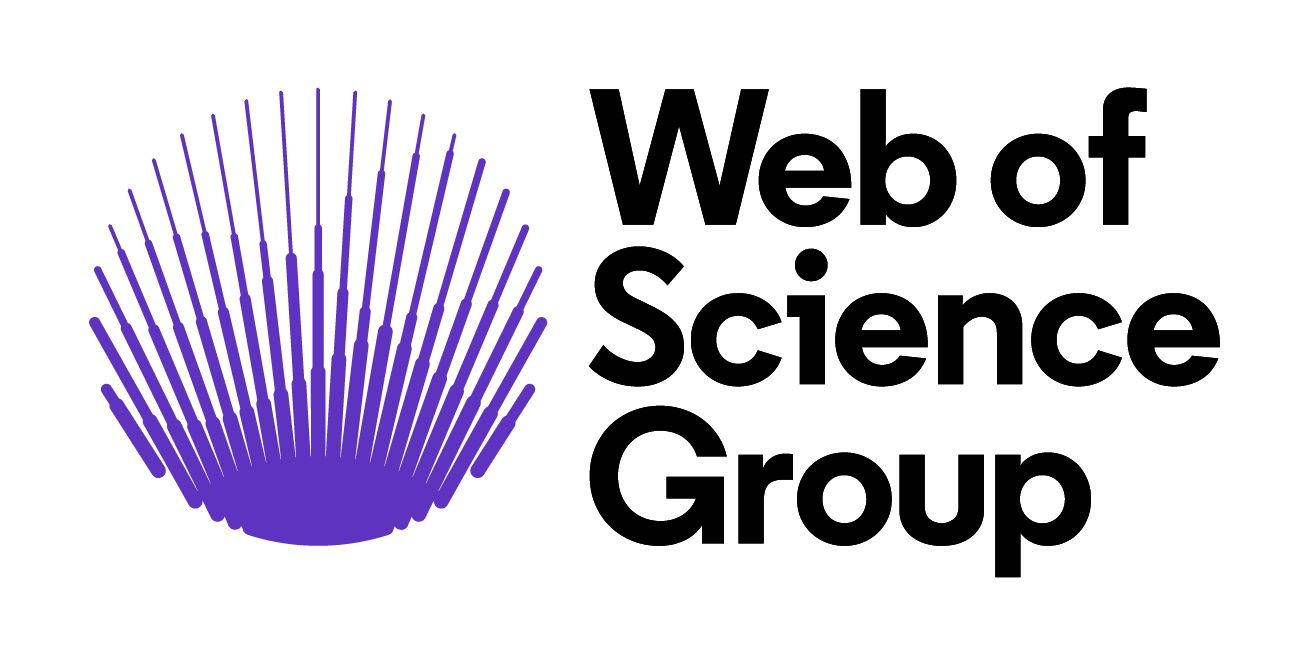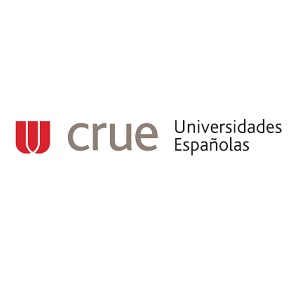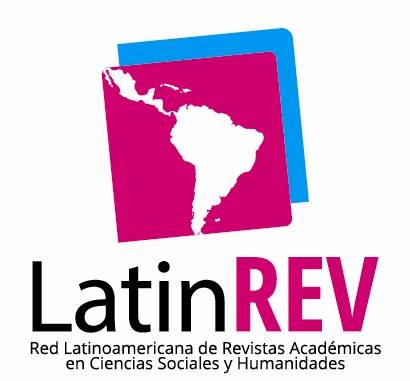Migrations and girl child rights in Europe. An anthropological perspective for agenda 2030 SDG5 implementation
Migraciones y Derechos de la Niña en Europa. Una mirada antropológica para la implementación del ODS5 de la agenda 2030
International legal standards for children’s rights and Girl Child Rights, strengthened by the global commitment of Agenda 2030 for Sustainable Development and its SDG5 on gender equality set, as a priority, the elimination of all forms of violence against girl children and girl adolescents. Among them, harmful traditional practices, including child, forced and early marriage and female genital mutilations (FGMs), tend to re-produce, increasingly, in European countries, in connection to migration processes and the extensión of habitats of meaning, therefore, representing a new challenge for States, receiving significant migration flows. In this framework, our anthropology of implementation work, by a gendered qualitative approach, aims at shedding light on this topic, proposing the case of France, in comparison to the on-going debate in other European countries and reflecting on the role of institutions and the close relationship between culture and legislation for implementation.
Los estándares jurídicos internacionales para los derechos de la infancia y, en particular, de las niñas, fortalecidos por el compromiso global de la Agenda 2030 para el Desarrollo Sostenible y su ODS5 sobre la igualdad de género establecen la prioridad de la eliminación de toda forma de violencia contra las niñas y las adolescentes. Entre otras, las prácticas tradicionales nocivas del matrimonio infantil, forzoso y precoz y las mutilaciones genitales femeninas (MGF), tienden a re-producirse, cada vez más, en países europeos, en conexión con procesos migratorios y la extensión de los hábitats de significado, convirtiéndose en un nuevo desafío para los países de destino. En este marco, nuestra antropología de la implementación, desde una perspectiva de género, pretende visibilizar este tema, reflexionando sobre el caso de Francia, en comparación con otros países europeos, el rol de las instituciones y la relación estrecha entre cultura y legislación para la implementación.
Referencias
Aragón, A. (2014). Migrations clandestines d’Amérique Centrale vers les Etats- Unis. Paris, France: Presses Sorbonne Nouvelle.
Annan, K. A. (1999). Foreword. En: Y. Danie- li, E. Stamatopoulou, C. J. Dias (Coord.), The Universal Declaration of Human Rights: Fifty Years and Beyond. New York, U.S.A: Published for and on behalf of the United Nations by Baywood Pub- lishing Company, Inc.
Appadurai, A. (2004). Modernità in polvere. Roma, Italia: Meltemi.
Binazzi, D. A. (2019). Género y migraciones forzosas en Centroamérica y el Cari- be. Una mirada antropológica para los derechos humanos de las niñas y adoles- centes y de las mujeres. In: Collectivus, Revista de Ciencias Sociales (CRSC), 6(1), monográfico titulado: Migraciones y género desde una perspectiva transnacional, Universidad del Atlántico, Colombia. ISSN 2382-4018. Available in:
http://investigaciones.uniatlantico.edu.co/revistas/index.php/Collectivus/article/view/2187
Binazzi, D. A. (2018). Los Derechos Humanos de Niñas, Niños y Adolescentes y el nuevo compromiso internacional para la Agenda 2030. Retos de la implementación entre lo global y lo local. Infancia y Adolescencia en Latinoamérica. No. 32. Revista Debates Latinoamericanos, Centro Latinoamericano de Estudios Avanzados (CLEA) y Red Latinoamericana de Cooperación Universitaria (RLCU), Buenos Aires, Argentina.
Binazzi, D. A. (2016). Discriminación de género y trabajo doméstico. Una mirada antropológica para los derechos de niñas, niños y adolescentes. In: Diversidades. Perspectivas multidisciplinarias para el estudio de la interculturalidad y el desarrollo social, F. Gervasi (Coord.), Universidad Autónoma de Coahuila, México: Ediciones del Laurel.
Binazzi, D. A. (2012). “Children’s rights e child protection. Il ruolo della ricerca internazionale per i diritti dei bambini”. In: Guetta S. (ed.), La voce della pace viene dal mare: Esperienze di cooperazione internazionale per la coesistenza fra culture, diritti e sviluppo umano, Aracne, Roma.
Cariño Trujillo, C. (2013). Epistemologías otras en la investigación social, subjetiidades en cuestión. 1A ed. Buenos Aires, Argentina: CLACSO E-Book. Disponible en: https://colectivociajpp.files.wordpress.com/2012/08/epistemolog-c3adas-otras-en-la-investigacic3b3n-so- cial-subjetividades-en-cuestic3b3n-car- mela-trujillo.pdf
Hannerz, U. (1998). La complessità culturale. L’organizzazione sociale del significato, Bologna, Italia: Il Mulino.
Harding, S. (1987). Is there a feminist method? In: Feminism and methodology. Bloomington/ Indianapolis USA: Indiana University Press.
Hodgking R. and Newell P. (September 2007). Implementation Handbook for the Convention on the Rights of the Child, New York-Geneva, Suiza: fully revised third edition, UNICEF.
Kilani, M. (2011). Antropologia. Una introduzione, Bari: Edizioni Dedalo.
Kilani, M. (2018). Du goût de l’autre. Fragments d’un discours cannibale, Paris, France: Seuil.
Ministère des Affaires Sociales, de la Santé et des Droits de Femmes. (October, 2014). La lettre de l’Observatoire National des Violences Faites aux Femmes, No.3. Available in: https://www.stop-violences-femmes.gouv.fr/IMG/pdf/La_lettre_de_l_Observatoire_national_des_violences_faites_aux_femmes_ no3_- OCT_2014-2.PDF
Olivier de Sardan, J. P. (2008). La rigueur du qualitatif. Les contraintes empiriques de l’interprétation socio-anthropologique, Belgica: Academia-Bruylant, LouvainLa-Neuve.
Pinheiro P. S. y United Nations. (2006). World report on violence against children: United Nations Secretary-General’s Global Study on violence against children, Geneva, Switzerland: United Nations.
Plan International. (2012). Because I am a Girl Global Campaign. Available in: https://plan-international.org/because-i-am-a-girl
U. N. Committee on the Rights of the Child. (28 September 2012). Report of the 2012 Day of General Discussion on the Rights of all Children in the context of international migration, Geneva, Switzerland: Author. Available in: https://www.ohchr.org/EN/HRBodies/CRC/Pages/Discussion2012.aspx
United Nations Convention on the Rights of the Child (UNCRC, 1989). Available in: http://www.ohchr.org/SP/Profession- alInterest/Pages/CRC.aspx
WEBSITES
AMREF, https://amref.fr/lamref-en-1ere-ligne-contre-les-mutilations-sexuelles-feminines/
BICE (Bureau International Catholique de l’Enfance), https://bice.org/fr/tu-pen- sais-partir-en-vacances-la-nouvelle-campagne-de-prevention-contre-l-excision/
Campaign Alerte Excision “Tu pensáis-partir en vacances?”, http://www.alerte-excision.org/
Men Speak Out Project http://menspeak-out.eu/?news=derniers-jours-offi-ciels-du-projet-men-speak-out&lang=fr.
U.N. International Day of the Girl Child. Available in: https://www.un.org/en/events/girlchild/
Visitas al artículo
Métricas Dimensions
Métricas PlumX
Descargas
Recibido: 3/11/2018
Aprobado: 7/02/2019
MIGRATIONS AND GIRL CHILD RIGHTS IN EUROPE.
AN ANTHROPOLOGICAL PERSPECTIVE FOR AGENDA 2030 SDG5 IMPLEMENTATION
ALICE BINAZZI*
ABSTRACT
International legal standards for children’s rights and Girl Child Rights, strengthened by the global commitment of Agenda 2030 for Sustainable Development and its SDG5 on gender equality set, as a priority, the elimination of all forms of violence against girl children and girl adolescents. Among them, harmful traditional practices, including child, forced and early marriage and female genital mutilations (FGMs), tend to reproduce, increasingly, in European countries, in connection to migration processes and the extension of habitats of meaning, therefore, representing a new challenge for States, receiving significant migration flows. In this framework, our anthropology of implementation work, by a gendered qualitative approach, aims at shedding light on this topic, proposing the case of France, in comparison to the ongoing debate in other European countries and reflecting on the role of institutions and the close relationship between culture and legislation for implementation.
KEYWORDS: Gender; migrations; Children’s Rights; Agenda 2030; child marriage and FGM.
MIGRACIONES Y DERECHOS DE LA NIÑA EN EUROPA.
UNA MIRADA ANTROPOLÓGICA PARA LA IMPLEMENTACIÓN DEL ODS 5 DE LA AGENDA 2030
RESUMEN
Los estándares jurídicos internacionales para los derechos de la infancia y, en particular, de las niñas, fortalecidos por el compromiso global de la Agenda 2030 para el Desarrollo Sostenible y su ODS5 sobre la igualdad de género establecen la prioridad de la eliminación de toda forma de violencia contra las niñas y las adolescentes. Entre otras, las prácticas tradicionales nocivas del matrimonio infantil, forzoso y precoz y las mutilaciones genitales femeninas (MGF), tienden a reproducirse, cada vez más, en países europeos, en conexión con procesos migratorios y la extensión de los hábitats de significado, convirtiéndose en un nuevo desafío para los países de destino. En este marco, nuestra antropología de la implementación, desde una perspectiva de género, pretende visibilizar este tema, reflexionando sobre el caso de Francia, en comparación con otros países europeos, el rol de las instituciones y la relación estrecha entre cultura y legislación para la implementación.
PALABRAS CLAVE: Género; migraciones; Derechos de la Infancia, Agenda 2030, matrimonio infantil y MGF.
1. INTRODUCTION
In Europe, girl children and girl adolescents closely related to migration processes also encompass settled and resident girl children of migrant families. These latter frequently find themselves at the crossroad of legislations, regulations and classifications on migration topics, particularly addressing adult people or groups of peer, such as unaccompanied children and migrant and asylum seekers girl children. This situation, paradoxically, might generate gaps in the safeguard and realization of the rights of girl children, having already settled, but still closely related to migration processes.
It is crucial to shed light on this peculiar situation, in destination countries of migration, in order to understand, in a better way, the existing need for prevention and protection from gender violence against minor-of-age girls. This particularly refers to harmful traditional practices, affecting them, addressed by the international legal standards and fostered by the Agenda 2030 SDG5. The institutional commitment, which arises for States receiving significant flows of migrations is, thus, fundamental in order to respond, appropriately, to State’s undertaken international commitments for safeguarding Girl Child Rights, gender equality achievement, as well as, the need for creating child protective environments for all children and adolescents, which requires a gendered perspective.
From the point of view of our anthropology of implementation (Binazzi, 2019), key-concept of this contribution and of the approach, by which we tackle on this topic, it is fundamental to analyse and shed light on the close relationship existing between culture and legislation and its influence on implementation action.
By constituting culture a core-concept for anthropology discipline, it can be useful to clarify that the anthropological language, used throughout this work, has to be referred to a definition of culture, mainly understood, as a matter of meaning, according to the theorization of culture, by Swedish anthropologist U.Hannerz (1998). “Culture” is the meanings, which people create, and which, in their turn, create people, as member of societies. In this sense, “culture” is collective. To study a culture means to study the ideas, the experiences, the feelings and the overt forms of these inner meanings, too, when they become public, and thus, social (Hannerz, 1998, p.3). The cultural flow consists in the externalization of meanings, produced by individuals and in the interpretation that individuals give of these externalizations (Hannerz, 1998, p.4). This dynamic view of culture, as an ongoing process, like the flow of a river, means that meaning’s expression continuously changes, recreating new flows of meaning. Therefore, culture can never be considered, as crystallized or homogeneous. In fact, different clusters of meaning, as countercultures, subcultures and micro cultures also exist, within a same collectivity, according to different actors’ perspectives, in a cultural process.
If, on one hand, under the pressure of extraordinary events, such as massive migratory flows, from contexts in conflict, recently received in the European continent, it was necessary to legislate, specifically and, often, rapidly, on the other hand, the guiding-principles, embedded in milestones of international legal standards, do constitute a call for keeping the focus on Children’s Rights’ foundations. It is of utmost importance, in our view, to study how the cultural dimension fits in institutional processes of interpretation and classifications, as rigid ones might also lead to disregard gender discrimination patterns, affecting vulnerable minor-of-age girls, which re-produce, in destination countries of migration. Some settled and resident girls, whose migration processes could be considered as already formally concluded, in destination countries, can still be under the influence of flows of meaning connected to their origin countries and at-risk of gender discrimination and harmful traditional practices, if originating from countries regularly practicing them. For this reason, these girl children and adolescents might be left-behind, when institutional “categories” do not apply to them or are culturally mis-interpreted. Therefore, they can result unsuitable and unable, juridically, to cover the gaps, generated by the habitats of meaning, also “migrating” with migrant people and, afterwards, undergoing a generational and geo-cultural mismatch, in the new diverse contexts of life.
In its first part, this work introduces the international legal standards for children’s rights and Girl Child Rights, as well as, the global commitment of Agenda 2030 and SDG5 for gender equality. The central part of this contribution offers a gendered anthropological analysis of French institutional response for prevention and protection, to contrast child marriage and FGMs, increasing, in connection to migration processes and the influence of cultural meanings in implementation processes. In the final part of this work, our qualitative reflection will explore the role of States and the on-going debate and positioning in other European countries, with respect of harmful traditional practices and “otherness of others” (Kilani, 2018; Kilani, 2011).
2. METHODOLOGY
This research, strongly committed for gender equality (Cariño Trujillo, 2013; Harding, 1987) and human rights of girl children and girl adolescents, offers an innovative qualitative approach, by developing an anthropology of implementation (Binazzi, 2019).
In the framework of the international legal standards for children’s rights and Girl Child Rights (UNCRC, 1989; Pinheiro and the United Nations, 2006; Hodgkin and Newell, 2007; Plan International, 2012), this approach combines a gendered anthropological analysis with the theory of human rights.
In the purpose of investigating the institutional role in implementation action for the realization of Girl Child Rights and gender equality, in connection to the interpretation and reflection of cultural meanings influencing implementation, this work conveys author’s previous qualitative research and international research outcomes for Girl Child Rights and migration processes, by international bodies and organisations. Concerning the case study of France, it offers cutting-edge ethnographical data, collected by the author, in the French context of Paris institutions and high-level organisations, according to the ethnographical field research strategy of French anthropologist J. P. Olivier de Sardan (2008).
3. INTERNATIONAL LEGAL STANDARDS FOR CHILDREN’S RIGHTS AND GIRL CHILD RIGHTS
Human rights’ acknowledgement of historically marginalised social groups, such as women and children’s ones, required a long process (Binazzi Daniel, 2012). The United Nations Convention on the Rights of the Child (UNCRC, 1989) represents a milestone of this process and it constitutes the principal instrument of the international legal standards for the safeguard of children’s rights1. UNCRC is the most widely ratified international instrument for human rights, by all world’s countries, except the United States of America (Binazzi Daniel, 2018).
Following the global recognition of children’s rights, this is the age of implementation (Annan, 1999), representing the main challenge, actually, because it still highlights considerable gender gaps, being girls’ rights seriously affected or disregarded, in comparison to boys’ ones. In fact, gender stereotypes and patriarchal patterns still affect fundamental rights of girl children and girl adolescents and their full development, also influencing their future choices and lives of adult women.
In 2012, ONU established the International Day of the Girl Child, 11 October (Plan International, 2012), to enhance awareness, concerning the existing inequalities between girls and boys and foster fight against gender discrimination and violence.
Girl children are more frequently affected, by the violation to their right to:
Education;
Active and equal participation;
Autonomous important decision-making for their future and bodies;
Justice and equal opportunities;
Protection from gender violence. (Plan International, 2012)
Therefore, we can observe that, in order to fulfil Girl Child Rights, it is crucial to safeguard Girl Child Rights to study, participate, decide and fully develop.
From an anthropological point of view, it is important to put in evidence that, when diversity of gender matches diversity of age, asymmetries of power increase, even in the environments supposed to offer child protection, such as families, schools, institutions, communities and society (Binazzi Daniel, 2016). Other diversities may intervene, such as origin and ethnicity, status and condition - as in the case of migrant girls - disabilities, religion, among others, determining a higher vulnerability or at-risk of violence situation for the girl child (Pinheiro P. S. and United Nations, 2006).
We consider, here, of particular relevance focusing on the analysis of migrant child condition, in order to, subsequently, highlight the peculiar elements of gender calling for a holistic approach to the protection of migrant girl rights, from a gendered perspective, in European destination countries.
This constitutes, from our point of view, a key point for implementation of girl child rights and gender equality achievement, as well as, for the fulfilment of international commitments that European States undertook, particularly, Agenda 2030 for Sustainable Development and its Goals (Sustainable Development Goals, SDGs), with particular reference to SDG 5 concerning gender equality (Binazzi Daniel, 2018).
4. MIGRANT CHILDREN, CHILDHOOD AND ADOLESCENCE LINKED TO MIGRATION PROCESSES
The U. N. Committee on the Rights of the Child is the body of independent experts responsible for reviewing UNCRC implementation progress, by each State Party, afterwards, delivering its recommendations. Due to the Committee’s mission to foster a deeper understanding of UNCRC, its contents and implications, when related to a specific topic, it stresses the primacy of the UNCRC, while tackling on children’s rights in transnational migration contexts, too.
Undoubtedly, there is the need to integrate UNCRC’s guiding-principles in migration-related framework, devices and measures. This Committee particularly indicates the UNCRC principles of best interest of the child and non-discrimination (Hodgkin and Newell, September 2007; Binazzi Daniel, 2018), in order to avoiding categories or distinctions regarding different kind of rights. International experts emphasize the importance of mainstreaming the rights of the child, into migration laws and processes, always giving attention to their peculiar needs (U.N. Committee on the Rights of the Child, 28 September 2012).
It is fundamental to recall that, according to legally-binding commitments undertaken by State Parties, all children involved in or affected by transnational migration are entitled to enjoy their rights, regardless of age, gender, ethnic or national origin, economic or documentation status, in voluntary or involuntary migration situation. This entitlement applies to accompanied children or unaccompanied, on the move or settled, documented or not.
It is important to insist on the principle of non-discrimination, bearing in mind that, for a consequence of migration’s reality involving children, a single child may fall into several categories, hence, rigid definitions or categorizations are not effective (U.N. Committee on the Rights of the Child, 28 September 2012).
Therefore, the role played by States is crucial in addressing all kind of rights’ violation of all children related to migrations, as well as, to mitigate their situations of vulnerability, by building child protection systems. In this sense, attention should be focused not only on migration situa- tions involving unaccompanied children. Child protection systems should include accompanied children, who must be considered autonomous rights-holders, in addition to benefitting from their par- ents’ ones, as well as, those who do not apply for asylum (U.N. Committee on the Rights of the Child, 28 September 2012).
In this sense, it is crucial, from our point of view, to include - within this group - also those children related to migrations, who settled, but who are still in vulnerable situations, such as those ones suffering gender discrimination. This is the case of resident or settled girl children and girl adolescents, related to migrations, in any case, at-risk of harmful traditional practices.
5. “…TO EACH CHILD WITHIN THEIR JURISDICTION…” (ART.2, UNCRC, 1989; HODGKIN AND NEWELL, 2007:23)
In the purpose of reiterating the existing legally-binding commitments, undertaken by State Parties, according to their ratification of the UNCRC and other international legal standards, to safeguard the rights of all children and to fight against discrimination, including gender’s one, we recall the first paragraph of UNCRC ART.2, stating the following:
“1. States Parties shall respect and ensure the rights set forth in the present Convention to each child within their jurisdiction without discrimination of any kind, irrespective of the child's or his or her parent's or legal guardian's race, colour, sex, language, religion, political or other opinion, national, ethnic or social origin, property, disability, birth or other status.” (Art. 2, UNCRC, 1989).
Therefore, it is of utmost importance to reaffirm, here, that UNCRC Art. 2 clearly establishes that all rights enshrined in the Convention “must apply to all children in the State, including visitors, refugees, children of migrant workers and those in the State, illegally” (Hodgkin and Newell, 2007, P.23).
According to Hodgkin and Newell (2007), once this principle is thoroughly understood, although it does not prevent per se - if single-handedly considered - it calls on the importance of differentiating, depending on different protection needs, especially, with regard to age and gender (p.3). Differentiation in prevention and protection, based on different needs, allows addressing all children, by avoiding misperceptions and left-behind recipients.
6. AGENDA 2030 SDG5 & HARMFUL TRADITIONAL PRACTICES
All aspects until here argued, lead, from our point of view, to the importance of not only emphasizing the need for prevention and protection for each child, directly affected or related to migration processes. It is also crucial to adopt a gendered perspective, in favour of migrant girl child rights.
The renewed global commitment of the Agenda 2030 and its Objectives (SDGs), approved in 2015, by the General Assembly of the United Nations, will influence children’s rights implementation areas, orienting implementation strategies and public policies, therefore, representing a challenge for world’s governments.
Although all 17 SDGs of the Agenda 2030 are interlinked and will produce effects on children’s and adolescents’ rights, SDG 5 “Achieve gender equality and empower all women and girls” is crucial for setting the priority of gender within the Agenda’s goals, supporting, at the same time, Girl Child Rights and the eradication of gender violence against minor-of-age girls.
By analysing SDG 5, we can observe that the roadmap to achieve gender equality and empowerment of all women and girls concentrates on a first group of targets, setting the overcoming of all forms of discrimination against them (5.1-5.4), including all forms of violence against them in public and private environment, including trafficking and sexual exploitation, among others (5.2). Afterwards, it highlights the commitment for encouraging participation (5.5), universal access to sexual and reproductive health (5.6) and to technologies and economic resources for empowerment (5.a-5.c).
Concerning Girl Child Rights, Goal 5, at its target 5.3, particularly focuses on the eradication of harmful traditional practices, including child, early and forced marriage and female genital mutilations (FGMs).
7. GIRLS IN BETWEEN DESTINATION AND ORIGIN COUNTRIES
7.1 Child Marriage in France
In France, Article 144 of Napoleonic Civil Code was still into force, until 2005. Adopted in 1804, it established the minimum age for marriage of 18 years, for men, and of 15 years for women.
This Article was amended, in 2005, by raising the minimum age for marriage to 18 years, for women and men, therefore, it abolished gender difference of age, although, it still safeguards the exception clause, concerning “special circumstances”. Incharged authority of the Procureur de la République, who can eventually decide to allow the marriage under “special circumstances”, can evaluate them.
In 2004, the Committee on the Rights of the Child had expressed its concern for this gender discrimination, with regard to legal marriage requirement foreseeing a lower age for girls in comparison to old- er men. In light of the recent growing of the phenomenon of child, forced or early marriage, it was recognised that this ancient French law left minor-of-age girls, as unprotected.
Prior to these amendments to Article 144 of the Napoleonic Civil Code, the authority of Haute Conseil à l’integration had estimated about 70.000 migrant adolescent girls and/or already resident girls of immigrant parents, who had been affected, by forced relations2.
More recently, an estimate concerning 4% of immigrated women living in France and 2% of girls, born in France from immigrated parents - all aged 26 to 50 years - were affected, by a marriage without their consent (Ministère des Affaires Sociales, de la Santé et des Droits de Femmes, October 2014).
In France, it was observed that, similarly to the dynamics of FGMs phenomenon, a higher risk for vulnerable girls develops, during the grandes vacances, i.e., the national pick holiday season, also matching summer school holidays, in July-August. This is the year time, during which girl children and girl adolescents usually travel abroad, to their origin countries. It is under these circumstances that they might be obliged to marry an adult man, before coming back to France.
In order to contrast this phenomenon, French law actually foresees a punishment of 3-year detention and 45.000 euros of sanction, for each person bringing a minor of age girl, abroad, in the purpose to get her married. By representing the absence of consent a cause of invalidity for marriage, this latter is automatically considered without consent, therefore as invalid, in presence of the minority of age of the spouse(s).
We could observe and reflect on the point of view, also supported by the Ministère des Affaires Sociales, de la Santé et des Droits de Femmes, during the International Conference, «Femmes en action contre l’excision!», in Paris, 22 February 2019.
Key-resource persons and specialists emphasized, during this Conference, the acknowledgement of forced and early marriage, as a violence denying freedom of choice to girl child or girl adolescent, prematurely imposing her, a wife’s and mother’s role.
Consequently, it is likely to affect her choices, while becoming an adult woman. Therefore, France affirms being strongly committed for contrasting forced and early marriage and gender violence under marriage condition, affecting girl children and girl adolescents (Ministère des Affaires Sociales, de la Santé et des Droits de Femmes, October 2014).
By the analysis of ART.171-7 of French Civil Code, we can note that, in this purpose, in case of application for transcription in France of a marriage celebrated abroad, by a foreign authority, French consulate authorities reserve the right to identify eventual elements that might invalid this marriage. If detected so, a formal communication must be transmitted, immediately, to the Ministry of Justice, in order to alert the Procureur de la République authority, to take the necessary steps.
Public policies of prevention and protection, focusing on these aspects, represent an effective implementation of the international legal standards for Girl Child Rights and gender equality achievement.
At the same time, feminist movements and committed research for children’s and migrant girls’ rights highlighted that, frequently, child marriage in local communities in origin countries is related to FGMs, as they result practiced to add local value to the child bride, in the purpose of marrying her, locally, as a result of dominating masculine patriarchal patterns.
In this sense, authorities and committed organisations intervened during the previously mentioned International Conference, in Paris, drew attention to the fact that contrasting child marriage also contribute to the eradication of FGMs and vice versa.
7.2 Implementation policies for FGMs eradication in France
The Ministry of Family, Childhood and Women’s Rights of France launched a national campaign, 3 March 2019, titled “Tu pensais partir en vacances?”3 (tr. Did you think leaving on holidays?), in the purpose of raising awareness, to fight against harmful traditional practices of FGMs against girl children and girl adolescents.
This campaign was planned in synergy with most credited NGOs, such as AMREF4 offering their expertise and experience on this topic, affecting girl children and adolescents, actually living in European countries. This initiative offers the first website in French for preventing and protecting girls, aged 12 to 18 years, from harmful traditional practices of FGMs. It particularly addresses those girls, who are related to migration processes from countries, where FGMs are usually practiced, therefore, resulting particularly at- risk of being affected by it.
This website, made available by the French Ministry, provides a child-friendly service with full information, tests and quiz, emergency numbers and support helpline to be called, as well as, useful interviews for empowering girls on their rights and how to defend themselves from the risk of becoming victims of harmful traditional practices. This campaign also launched in social networks and television channels will be active until the pick summer season of holidays departures, having as its main objective of alerting young girls of this higher risk during this time, as it frequently happens, by secretly taking advantage of girl’s travel to her origin country.
This implementation action for the realization of girl child rights and gender equality aims to respond, institutionally, to such extreme forms of gender violence, linked to masculine control on women’s bodies and their freedom of choice, by concretely tackling on vulnerability’s issues affecting the rights of migrant minor-of-age girls. By doing so, French State undertook its commitment and responsibility to prevent and protect the best interest of the girl child and her right to life, survival and development, of no-discrimination and of respect for the view of the child, which constitute the guiding-principles of the UNCRC (Hodgkin and Newell, september 2007).
While particularly focusing on the rights of girl children linked to migration processes, this government commitment is supporting the implementation of the guiding-principles for children’s rights, as well as, gender equality and the action for Agenda 2030 SDG 5.
We can here observe that this implementation sheds light, at the same time, on endogenous gender violence, also existing within family relations and persisting, after having settled and concluded a migration processes and while carrying out a new life in a destination country. Gender discrimination affecting migrant girls, more frequently visible and represented by media, highlights exogenous forms of marginalisation, exclusion and violence, perpetrated against them, by local contexts of destination countries.
Nevertheless, it is crucial to tackle on, analyse and make visible the hidden forms of gender discrimination, affecting these girls. Discrimination and violence are generated, in a less visible way, by endogenous processes of cultural flows of meanings (Hannerz, 1998).
Here, we can highlight that these meanings are re-produced, abroad, within migrant families and communities, also stressed, by “imagined” home country and related representations, somehow compensating difficulties in coping with new life challenges in a foreign country (Appadurai, 2004).
These overt forms of inner meanings (Hannerz, 1998) are directly linked to local origin contexts and regularly fed by at-distance interactions, with local family and community, now facilitated by new technologies. It is in this kind of flows that habitats of meanings, crossing national borders, are moulded and stretched, in a “tension” between “origin” and “destination”. Some migrant families maintain patriarchal patterns, as well as, “at-distance dependence” from hierarchical and conservatory relations, in origin context, influencing their behaviour and choices, abroad, in destination countries. It is in this context that settled and resident girls are more likely to become victims of these harmful practices.
In our opinion, institutional prevention and protection measures should reach these habitats of meanings, in order to influence them, advocating for Girl Child Rights and supporting harmonized inclusive processes and social change, particularly but not only, in destination countries.
The French institutional initiative of implementation to eradicate FGMs involved the governmental Agency for international cooperation AFD (Agence Française de Développement) that conveyed, in the previously mentioned International Conference, «Femmes en action contre l’excision!», in Paris, 22 February 2019, several committed NGOs, associations, feminist activists and civil society to reflect on new dimensions of this phenomenon, actually become as transnational. This directly implies an institutional responsibility to fulfil the undertaken international commitments. It primarily includes the implementation of international legal standards for children’s rights, embedding the rights of migrant minor-of-age girls; eradication of child and forced marriage and FGMs, as from SDG5 priority, and, in a broader sense, the commitment for gender equality achievement.
It exists an estimation of thirty countries practicing FGMs, in the world and 200 millions of women victims, among whom, 44 million younger than 15 years5. It was also estimated that, in Europe, girl child victims for this practice are about 500.000, of whom, 13.000 only in Bel- gium6.
Last official report by the Institut National d’Etudes Démographiques (INED) indicated an estimation of 50.000 adolescent victims, in France, although, a number of 60.000 is more likely to approximate to reality, according to the field work of committed organizations and social workers7.
FGMs are currently practiced in Africa (in Guinee, it exists 96% of FGMs, while high percentage also exist in Mali, Sudan, Egypt and Somalia), in South-East Asia and in Latin America (Peru and Colombia). Three out of ten girl children and adolescents, related to migration processes and regularly resident in France, are at-risk of becoming victims, during their vacations in their origin countries. In compliance with UNCRC requirements, French law protects children and adolescents, in its territory and jurisdiction, regardless their nationality or diversity, of any kind. Concerning the harmful traditional practice of FGMs, French law establishes a punishment of twenty years detention and a 150.000 euro sanction.
Feminists and NGO’s activists intervening in the International Conference, in Paris, pointed out that intra-regional migration patterns also take place, in connection to harmful traditional practices, although they are scarcely disclosed. African feminists reported that very little girls are frequently transferred from Kenya, where law against FGMs are very strict, to Ethiopia or to other neighbour countries, where laws against FGMs are “more flexible”. These forced migrations, within the region, are undertaken in the purpose of perpetrating this gender violence, somehow, relaying on a certain impunity, still existing in some countries, towards these practices.
Sometimes, transnational migration processes do not allow overcoming gender violence against little girls and adolescents, as habitats of meaning do travel with migrant people (Appadurai, 2004) and living in Europe, Canada or United States do not imply, per se, protection for girls from this invisible gender violence.
In Europe, 180.000 at-risk girl children and adolescents are estimated, each year.
7.3 Implementation addressing accompanied asylum-seeker girl children and adolescents
A relevant implementation policy to be mentioned, for SDG 5 achievement and eradication of MGFs harmful traditional practice, is carried out, in Paris. This is currently developed, by the institution of Office français de protection des refugiés et apatrides (OFPRA), together with the public health assistance of Hopitaux de Paris (Hotel-Dieu) and it foresees the realization of medical-judiciary examinations for prevention and protection of at-risk of FGMs girl children and adolescents.
Medical examinations are needed by OFPRA, as a pre-requirement, before starting asylum procedures for refugee girls, as well as, its confirmation, afterwards, to keep on protecting them. Until 30 September 2018, 7.300 minor-of-age girls were assisted by OFPRA, according to a strategy, which has considerably evolved, throughout the last decade.
In 2009, the National Court for the right to asylum, in France, had established that FGMs constitute a relevant justification, in order to obtain an asylum permit, for representing FGMs an inhuman and degrading treatment. In 2012, the Conseil d’Etat had acknowledged the risk of becoming victims of FGMs, as an entitlement for refugee status, according to the international legal standards of the Geneva Convention and taking into consideration the existence of ties with an origin country, where FGMs constitute a social norm. Nevertheless, the implementation of this device could not separate minor-of-age girls from their parents. Therefore, parents not yet holding their refugee permit could benefit from their daughter(s) permit’s extension to them.
In the purpose of protecting migrant girls’ rights, OFPRA receives initial medical certifications, by the in-charged hospital unit and after making its decision of activating this protection process. In order to make sure of the preservation of girl’s physical integrity, subsequently, it is mandatory to renew this certificate, in a maximum delay of 3 years, in-between these two certificates. Girl’s parents or legal representatives can receive their refugee status, too. In case of crime’s discovering, OFPRA must inform the Procureur de la République, to apply the corresponding Penal Code punishment.
It is important to underline that, according to the best interest of the girl child, her refugee status is individual and it does not depend on her parents’ or legal representative(s)’ one. Their eventual renounce or loss of refugee status will, in no way, affect girl’s refugee status.
French implementation for migrant girl children’s rights and for the eradication of harmful traditional practices against them can be considered, in our opinion, as a virtuous practice, if we analyse it from human rights theory’s perspective, as it fully responds to the international legal standards of reference.
The four guiding-principles of UNCRC of no-discrimination, best interest of the child, right to life, survivor and full development and respect for child’s views result to be respected in full, by this implementation’s action.
Concerning advocacy and participation, we consider of interest, for our reflection, to put in evidence the opinion of committed adult women against FGMs, who participated in Paris Conference, which could be observed by this field research. In that occasion, these women could express their point of view about the importance of men and boys participation for the achievement of this goal.
Women fighting against child marriage and FGMs consider dialogue with men of utmost importance to raise awareness among them, by stressing the responsibilities that their roles of fathers and husbands imply and bearing in mind the seriousness of health consequences for girl victims.
Women leading action against FGMs and building bridges, in particular, between Europe and Africa, emphasize the importance of empowering men and boys, to involve them in the process for this common goal.
African feminists consider dialogue with men, as fundamental. Although cultural and social change represents a process of transformation, needing of time and patience, from their point of view, this cannot avoid doing all efforts to convince men who, due to the existing patriarchal patterns, are those who are making decisions, locally. In this sense, African women internationally committed for the eradication of harmful traditional practices mention, as an example of good practice, the Project Men Speak Out8, in Belgium, developed in the framework of Daphne Programme of the European Commission and concluded in 2017, after, successfully, carrying out a relevant action of awareness raising and empowerment among men, on this topic.
8. THE ROLE OF STATE PARTIES AS DESTINATION COUNTRIES OF MIGRATION
Our reflection on contemporary phenomena of girl children’s rights violations interlinks with the role played by governments for prevention, protection and implementation.
European countries, as destination territory of transnational migrations, should be accountable for safeguarding migrant Girl Child Rights and the fulfilment of Agenda 2030 SDG5. Due to international law and reciprocity criteria, European countries receiving major flows of migrants registered an increasing of applications to homologate marriages performed abroad, often resulting in the reality of a minor-of-age girl married with an adult man.
Consequently, some States, as France, legislated to prohibit this phenomenon, protecting girls and avoiding the possibility that this kind of marriages become valid, producing legal effects, in French territory, too. Other States, as Germany, after a first inclination to legislate in the same sense, afterwards, changed of orientation, opting for a “politically correct” strategy and homologating marriages performed abroad, in Germany, too, although their celebration was based on Islamic law of sharia, foreseeing no minimum age for girls to get married.
In 2015, the arrival of massive migrations to Germany, according to data of German Ministry of Internal Affairs, registered a rise of child marriages. After receiving this considerable flow of migrant people –mostly from Middle East, Asia and Africa– German authorities identified the existence of 1475 married minor-of-age girls, a part of them aged less than 14 years, living in this country. After the renowned case of Bamberg, where a Syrian girl, aged 15 years, resulted married with her cousin of 21 years, in 2017, German Parliament approved a new law, raising the age for marriage from previous 16 years up to 18 years for women and men. In December 2018, the German Federal Court of Justice declare the unconstitutionality of this law, considered to violate Die Grundrechte (tr. fundamental rights), acting as Constitution, in Germany, with respect to the acknowledgement of the freedom of choice, including of marrying and having a family.
National debate and critics, afterwards, focused on the incompatibility of introducing the application of foreign standards, in Germany, based on religious prescriptions and contrasting with German law principles of best interest of the child, the right of the girl child to health and full development and non-discrimination. So far, no new law to contrast gender discrimination and child, early or forced marriage has entry into force, in Germany, and age for marriage is still of 16 years, also homologating marriages, celebrated in foreign countries with minor of age girls.
A similar debate is ongoing in other countries, too, such as Denmark. In fact, a considerable confusion was generated, due to a “confluence” or “conflict” between the mere “correct” acceptance of “other” cultural meanings, when they might be, concretely, affecting Girl Child Rights and the compliance of the global commitment for gender equality, eradication of gender violence and harmful traditional practice and the implementation for girl Child Rights.
States of Northern Europe found themselves in the same political and cultural impasse. This clearly highlights the lack for a gendered and holistic approach, among European countries, for the implementation of the rights of girls related to migrations, in a broader sense, i.e., also including those ones, having settled or born in destination countries, but still affected by habitats of meanings, patriarchal patterns, gender discrimination and violence, putting them at risk of harmful traditional practices.
A common gendered approach to this topic, in Europe, should be able to harmonize the undertaken global commitment for Agenda 2030 and SDG 5, with the peculiarities of the implementation in their local contexts.
Considering the high numbers of FGMs victims, among migrant, settled and resident girls, in European contexts, as well as, the raise of applications for homologating marriages abroad, our convincement is that a comprehensive approach for implementation should be agreed among European countries, referring to harmful traditional practices, as practices having similar or same root-causes and interlinked dynamics.
This approach should bring in, the international legal standards for children’s rights and Girl Child Rights, research contribution from gender studies and a deep thorough anthropological reflection on cultural flows in connection with migration processes and the related legislations, regulations and “category” definitions, in European destination countries. This would allow putting in place appropriate public policies, filling the existing gaps, and advocate, effectively, for gender equality. In this sense, the case of France represents, from our point of view, an example of good practices for implementation, which possibly, might be “transferable” to other European countries.
9. CONCLUSIVE REFLECTIONS
From our anthropological point of view of implementation, the discrepancy arising between respecting cultural diversity and its habitats of meanings supporting gender discrimination and violence, in destination countries of migration, and the safeguard of rights of vulnerable and at-risk minor-of-age girls, related to migration processes, imposes a serious institutional reflection and a certain coherence for implementation.
The guiding principles of the best interest of the child and of non-discrimination should always prevail in issues, involving the social group of girl children and girl adolescents. This entails coherence and consistency with international legal standards for human rights that Europe, in its whole, ratified and embedded in their legislations, as part of its commitment for implementation. Furthermore, Europe is supporting Agenda 2030 and its goals that build upon human rights principles and progress made, so far, in this area, especially in terms of acquired competence and lessons learnt.
Therefore, any misunderstanding should be avoided that might cause a certain con- fusion, among the different levels of a country’s accountability, deriving from assuming politically correct positions, somehow conflicting with institutional legally-binding commitments for Girl Child Rights. It is at least contradictory, from one hand, to support the global commitment for sustainable development and gender equality, embedding the eradication of gender violence and harmful traditional practices against all women and girls, and, from the other hand, to allow, at national level, the homologation of harmful traditional practices, denying it and/or avoiding contrasting them. This reflection directly apply to all girl children and girl adolescents, related to migration processes.
Despite the existing guidelines, by the Council of Europe, on gender equality and children’s rights, the difference of implementation among European States, on these topics, represents a serious matter, also reflecting on the international level of credibility, while claiming other world’s regions for implementation of international standards that do not find a concrete implementation, yet, in European region.
Our work has highlighted that it exists not only exogenous gender discrimination and violence of local contexts, in destination countries of migrations, against minor-of-age girls related to migrations. It also exists a hidden endogenous violence, within migrant families and communities, re-producing habitats of meaning of patriarchal patterns and gender violence in destination countries, too. This was clearly put in evidence, by the analysis of the case study of France and its institutional approach response to the phenomenon of harmful traditional practices, affecting not only migrant and asylum seeker girls, but also already settled, resident and French born girl children and adolescents.
Therefore, this gender violence is no longer ascribable only to a far-away local context. It is of utmost importance to investigate, identify and make visible these new forms of national-transnational gender violence against girls related to migrations, being a topic still scarcely worked, due to invisibility, in which these phenomena develop, within family and migrant community and in cultural and spatial “oscillation”, between country of origin and destination country. Although addressing this kind of gender violence represent a real challenge, Girl Child Rights and the struggle for gender equality must prevail, considering that also settled and resident girl children and adolescents related to migration acquired new habitats of meaning and consider themselves, as citizens of the destination country.
Furthermore, they are not empowered, concerning the risk of the re-production of harmful traditional practices, frequently, during a holiday travel to their origin countries or of their family, especially, if they were born in destination countries.
It has to be stressed that, as observed in the case of France, by this research, nowadays, the real challenge for gender equality and eradication of gender violence is represented by involving men and boys in the process for social change. Since more than one decade, the international cooperation for human rights and sustainable development indicates that awareness raising and empowerment of girls and women for their rights and for gender equality is only a part of its implementation.
European States, relaying on existing principles of children’s rights and gender equality, are called – in the purpose of implementing – to address those enduring cultural processes against girl children, re-producing within the gaps of legislative categories, unable to cover the full extension of overt forms of cultural meanings.
We consider of interest, to conclude, here, by the following words of the Guatemalan anthropologist and sociologist A. Aragón (2014), forming part of the wide Latin American scholar community, in Paris, and expert on migration flows in Central America:
La science sociale est une pensés libre, sans contraintes, alors que le politique est le lieu du compromise et de l’immédiat. Le défi de la démocratie en ce début du XXIème siècle semble être de s’élever vers l’échelle globale et cosmopolitique, et celui des sciences sociales d’inventer les leviers pour l’accompagner. (Aragón, 2014:238)
This author’s reflection highlights the highly significant roles and potential synergies of social sciences and politics, in contemporary globalized world.
BIBLIOGRAPHIC REFERENCES
Aragón, A. (2014). Migrations clandestines d’Amérique Centrale vers les Etats- Unis. Paris, France: Presses Sorbonne Nouvelle.
Annan, K. A. (1999). Foreword. En: Y. Danie- li, E. Stamatopoulou, C. J. Dias (Coord.), The Universal Declaration of Human Rights: Fifty Years and Beyond. New York, U.S.A: Published for and on behalf of the United Nations by Baywood Pub- lishing Company, Inc.
Appadurai, A. (2004). Modernità in polvere. Roma, Italia: Meltemi.
Binazzi, D. A. (2019). Género y migraciones forzosas en Centroamérica y el Cari- be. Una mirada antropológica para los derechos humanos de las niñas y adoles- centes y de las mujeres. In: Collectivus, Revista de Ciencias Sociales (CRSC), 6(1), monográfico titulado: Migraciones y género desde una perspectiva transnacional, Universidad del Atlántico, Colombia. ISSN 2382-4018. Available in:
http://investigaciones.uniatlantico.edu.co/revistas/index.php/Collectivus/article/view/2187
Binazzi, D. A. (2018). Los Derechos Humanos de Niñas, Niños y Adolescentes y el nuevo compromiso internacional para la Agenda 2030. Retos de la implementación entre lo global y lo local. Infancia y Adolescencia en Latinoamérica. No. 32. Revista Debates Latinoamericanos, Centro Latinoamericano de Estudios Avanzados (CLEA) y Red Latinoamericana de Cooperación Universitaria (RLCU), Buenos Aires, Argentina.
Binazzi, D. A. (2016). Discriminación de género y trabajo doméstico. Una mirada antropológica para los derechos de niñas, niños y adolescentes. In: Diversidades. Perspectivas multidisciplinarias para el estudio de la interculturalidad y el desarrollo social, F. Gervasi (Coord.), Universidad Autónoma de Coahuila, México: Ediciones del Laurel.
Binazzi, D. A. (2012). “Children’s rights e child protection. Il ruolo della ricerca internazionale per i diritti dei bambini”. In: Guetta S. (ed.), La voce della pace viene dal mare: Esperienze di cooperazione internazionale per la coesistenza fra culture, diritti e sviluppo umano, Aracne, Roma.
Cariño Trujillo, C. (2013). Epistemologías otras en la investigación social, subjetiidades en cuestión. 1A ed. Buenos Aires, Argentina: CLACSO E-Book. Disponible en: https://colectivociajpp.files.wordpress.com/2012/08/epistemolog-c3adas-otras-en-la-investigacic3b3n-so- cial-subjetividades-en-cuestic3b3n-car- mela-trujillo.pdf
Hannerz, U. (1998). La complessità culturale. L’organizzazione sociale del significato, Bologna, Italia: Il Mulino.
Harding, S. (1987). Is there a feminist method? In: Feminism and methodology. Bloomington/ Indianapolis USA: Indiana University Press.
Hodgking R. and Newell P. (September 2007). Implementation Handbook for the Convention on the Rights of the Child, New York-Geneva, Suiza: fully revised third edition, UNICEF.
Kilani, M. (2011). Antropologia. Una introduzione, Bari: Edizioni Dedalo.
Kilani, M. (2018). Du goût de l’autre. Fragments d’un discours cannibale, Paris, France: Seuil.
Ministère des Affaires Sociales, de la Santé et des Droits de Femmes. (October, 2014). La lettre de l’Observatoire National des Violences Faites aux Femmes, No.3. Available in: https://www.stop-violences-femmes.gouv.fr/IMG/pdf/La_lettre_de_l_Observatoire_national_des_violences_faites_aux_femmes_ no3_- OCT_2014-2.PDF
Olivier de Sardan, J. P. (2008). La rigueur du qualitatif. Les contraintes empiriques de l’interprétation socio-anthropologique, Belgica: Academia-Bruylant, LouvainLa-Neuve.
Pinheiro P. S. y United Nations. (2006). World report on violence against children: United Nations Secretary-General’s Global Study on violence against children, Geneva, Switzerland: United Nations.
Plan International. (2012). Because I am a Girl Global Campaign. Available in: https://plan-international.org/because-i-am-a-girl
U. N. Committee on the Rights of the Child. (28 September 2012). Report of the 2012 Day of General Discussion on the Rights of all Children in the context of international migration, Geneva, Switzerland: Author. Available in: https://www.ohchr.org/EN/HRBodies/CRC/Pages/Discussion2012.aspx
United Nations Convention on the Rights of the Child (UNCRC, 1989). Available in: http://www.ohchr.org/SP/Profession- alInterest/Pages/CRC.aspx
WEBSITES
AMREF, https://amref.fr/lamref-en-1ere-ligne-contre-les-mutilations-sexuelles-feminines/
BICE (Bureau International Catholique de l’Enfance), https://bice.org/fr/tu-pen- sais-partir-en-vacances-la-nouvelle-campagne-de-prevention-contre-l-excision/
Campaign Alerte Excision “Tu pensáis-partir en vacances?”, http://www.alerte-excision.org/
Men Speak Out Project http://menspeak-out.eu/?news=derniers-jours-offi-ciels-du-projet-men-speak-out&lang=fr.
U.N. International Day of the Girl Child. Available in: https://www.un.org/en/events/girlchild/
PARA CITAR ESTE ARTÍCULO
Binazzi, A. (2019). Migrations and girl child rights in Europe. An anthropological perspective for agenda 2030 SDG5 implementation. Collectivus, Revista de Ciencias Sociales, 6(2), 13-32.
DOI: http://dx.doi.org/10.15648/Coll.2.2019.2
* PhD Anthropologist and researcher in international projects and specialist in gender and children’s rights, Department of Education Sciences and Psychology (SCIFOPSI), University of Florence, Via Laura, 48, 50121. Florence, Italy. E-mail address: alicebinazzidaniel@yahoo.com
1 UNCRC and all international legal standards for children’s rights consider as a «child» each person, aged 0 to 18 years.
2 Source: AMF (Association de Maires de France, i.e., the association of Mayor of France).
3 Campaign Alerte Excision “Tu pensáis-partir en vacances?”, http://www.alerte-excision.org/
5 Source: BICE (Bureau International Catholique de l’Enfance), https://bice.org/fr/tu-pensais- partir-en-vacances-la-nouvelle-campagne- de-prevention-contre-l-excision/
6 Source: Alerte Excision and National Cam- paign “Tu pensáis-partir en vacances?”, http://www.alerte-excision.org
7 Source: Alerte Excision and National Cam- paign “Tu pensáis-partir en vacances?”, http://www.alerte-excision.org/
8 Source: Men Speak Out Project http://men-speakout.eu/?news=derniers-jours-offi-ciels-du-projetmen-speak-out&lang=fr
Los originales publicados en Collectivus, Revista de Ciencias Sociales, son propiedad de la Universidad del Atlántico, siendo necesario citar la procedencia en cualquier reproducción parcial o total.
Importante: Los artículos publicados en la Revista Collectivus son responsabilidad exclusividad de sus autores y no comprometen el pensamiento de los miembros de la estructura editorial de la revista.
Los derechos de autor pertenecen a Collectivus, Revista de Ciencias Sociales. Por ello, la reproducción total o parcial del material publicado está prohibida, salvo autorización previa y conforme a los estándares de licencia de uso y distribución “Creative Commons Reconocimiento-No Comercial 4.0 Internacional”.


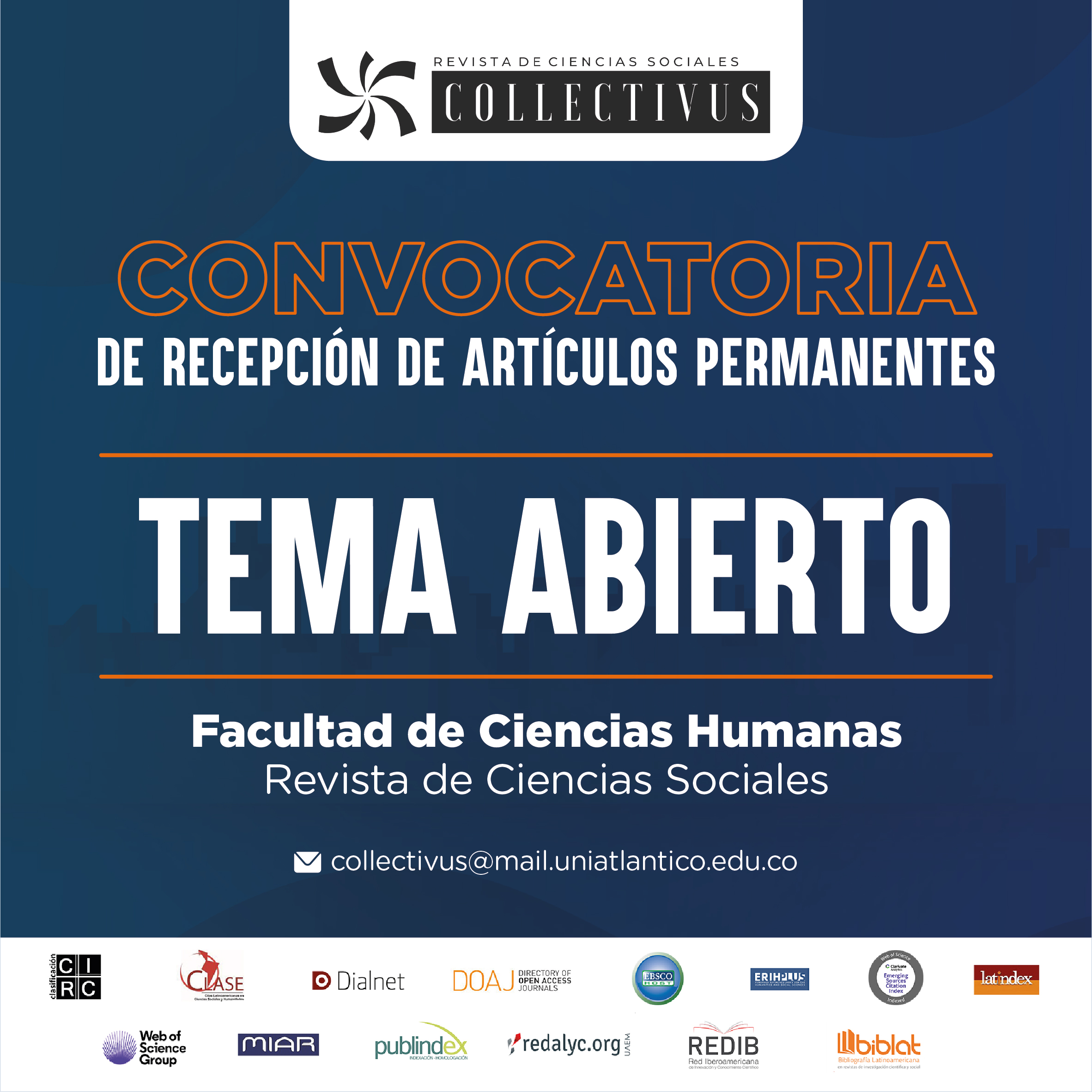




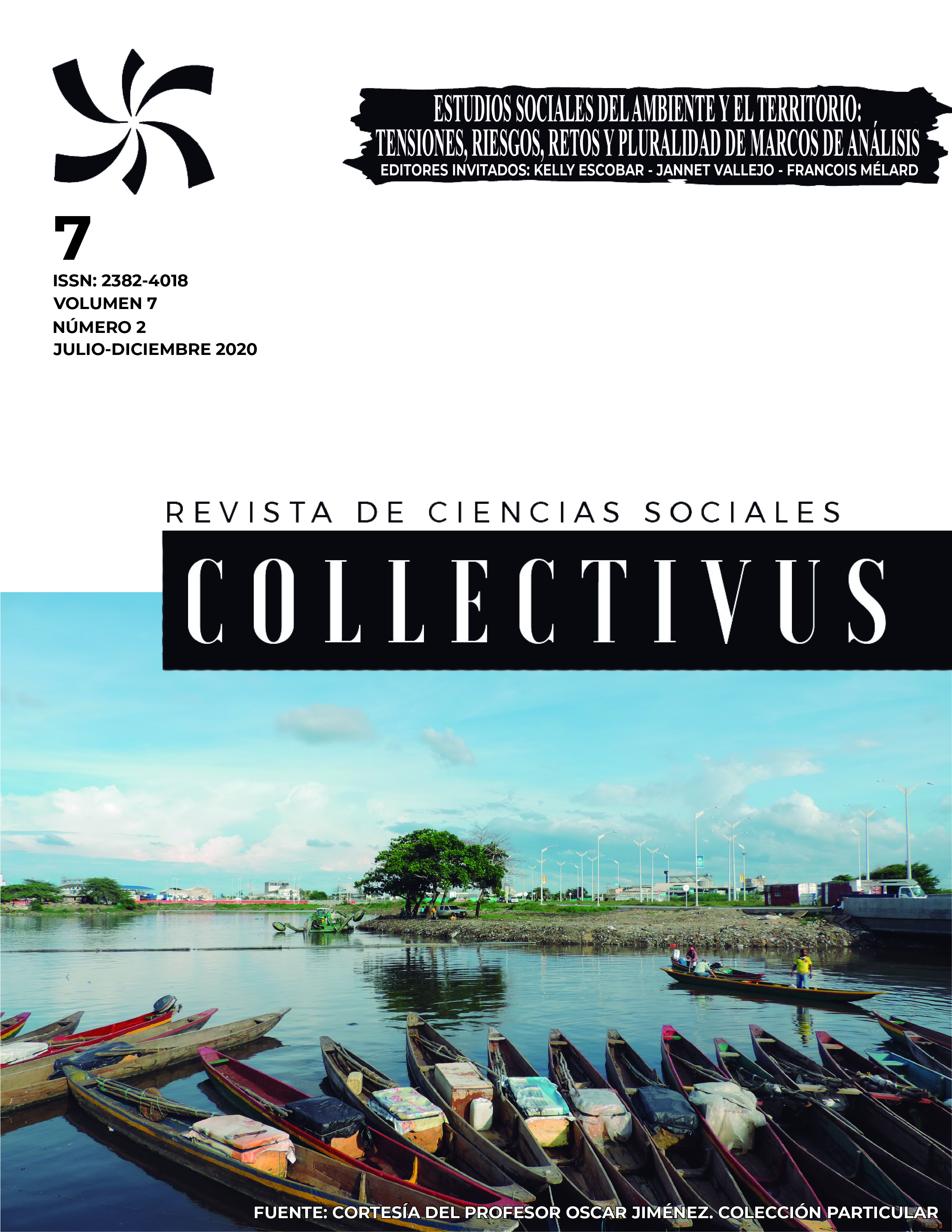


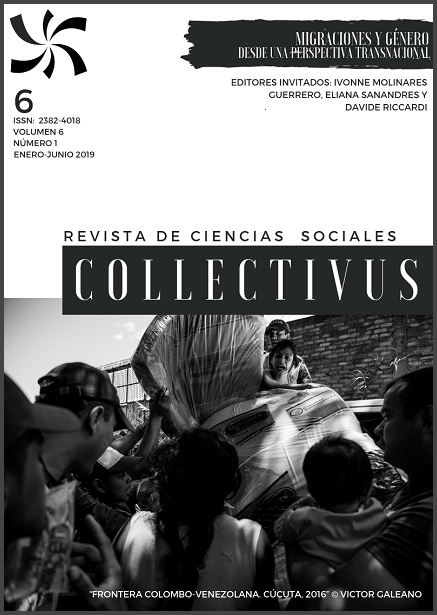










.jpg)
.PNG)



